Jun'ichiro ISHII is Paris and Kyoto-based conceptual artist.
Don't wanna be here? Send us removal request.
Text
One day Cyprus | いつかのキプロス
When I first visited Cyprus in 2021, I was drawn to a large ceramic plate featuring a design said to have been popular in the 14th century.
The image, traditionally associated with marriage, depicts two figures sharing a single, oversized dress. While their bodies, wrapped in one garment, suggest physical constraint and the potential for discomfort, the image also evokes a sense of warmth and intimacy in their closeness.
At the same time, this motif of “two heads sharing one body” struck me—strangely—as a symbolic reflection of Cyprus’s current situation. My work A Cyprus Yet to Come consists of a hanger designed to hold a dress for two people, along with a replica of the plate sold as a souvenir. What’s missing here may be the dress itself.
Through this work, I hope to invite viewers to imagine and reflect on this “invisible dress.”

One day Cyprus © 2024 Jun'ichiro ISHII
2021年に初めてキプロスを訪れた際、最初に関心を惹かれたのは、14世紀の図案が描かれた大皿でした。
結婚の際に好んで用いられたというその絵には、大きなドレスをふたりで纏った人物が描かれています。ひとつの衣服にふたりの身体が包まれているその姿は、動きを制限し、不便を生じさせ��可能性を孕みながらも、寄り添う暖かさや親密さのようなものも想起させます。
同時に、「ひとつの身体にふたつの頭」というこの図像は、奇妙にも今日のキプロスの状況をも象徴しているかのように感じられました。 本作《いつかのキプロス》は、ふたりで身に着けることができる大きなドレスを掛けるためのハンガーと、土産物として販売されているレプリカの大皿によって構成されています。 ここに欠けているのは、ただ一着のドレスかもしれません。
本作を通して、わたしは「見えないドレス」に想いを巡らせたいと考えています。
Exhibition : 2023.10.13-11.20 "3rd Larnaca Biennale / To the Sea, with Her Names" Athienou, Cyprus 2024.06.07-07.14 "3rd Larnaca Biennale / To the Sea, with Her Names" KIKA gallery, Kyoto 2024.08.03-08.11 "3rd Larnaca Biennale / To the Sea, with Her Names" HIGURE 17-15 cas, Tokyo
Curated by Shaoan Huang (TW) Supported by Larnaca Biennale
0 notes
Text
Chai on the Balance at Ankara

Chai on the Balance at Ankara, Turkey © 2024 Jun'ichiro ISHII
About the work
Exhibition : 2024.02.25 - 04.14 "Shared Memory" CerModern, Ankara, Turkey
Curated by Deniz Erbas (TR) / Seyhan Boztepe (TR) Supported by Çanakkale Biennial / Institut français Ankara
0 notes
Text
URUSHI PROJECT

URUSHI PROJECT © 2022 Jun'ichiro ISHII
URUSHI PROJECT designed by Jun'ichiro ISHII / Collaborate with Ryuji Onari and Mizuki Kajihara
Presentation / Exhibition : 2024.10.22-10.29. "African Art in Kyoto 2024" Sennyu-ji Temple Shariden, Kyoto, Japan 2024.06.04 - 06.09. "Urushi trees and Ostranenie" Art space Saga, Kyoto Saga University of Arts, Japan 2023.12.08 - 12.24. "URUSHI PROJECT 2023 - the progress" KIKA gallery, Kyoto, Japan 2022.09.31 - 10.16. "URUSHI PROJECT 2022 autumn in Kyoto" KIKA gallery, Kyoto, Japan 2022.08.05 - 08.20. "URUSHI PROJECT 2022 summer in Tokyo" HIGURE 17-15 cas, Tokyo, Japan 2021.10.01 - 10.10. "C y c l e ― Reincarnation ―" Space TaTE 680, Kyoto, Japan 2021.08.07 - 08.22. "If a wood falls in a forest…" HIGURE 17-15 cas, Tokyo, Japan
Video screened : 2024.10.04 - 11.11 "9th Çanakkale Biennial - Let Time Run its Course" Çanakkale, Turkey
【>> 日本語でもっと読む】 【>> Read more in English】
0 notes
Text
Global Flag
The exhibition “Fantasy Island” was organized by the “International Art Community Networking Project” in Incheon Metropolitan City, South Korea, in July 2023, which coincided with the 70th anniversary of the ceasefire that ended the Korean War. I improvised a work called Global Flag, specific to the location and context of this exhibition, which included about 20 international artists from Turkey, Nepal, Thailand, Hong Kong, etc., and Korean artists of different generations. Global Flag consisted of flags made of transparent vinyl sheets, a “floating island” in a pond outside the exhibition venue and decorative flag garlands often used in world expositions. The symbolism of the “invisible flag” goes without saying, but the work calls into question the idea of national borders, national identity, and the legitimacy of the nation-state. I also chose to use transparent vinyl sheets as they were used during the Covid-19 pandemic from 2020 to divide people like our national “borders”.

Specific improvisation for site and context, ≪ Global Flag ≫, Incheon, South Korea. © 2023 Jun'ichiro ISHII
「Fantasy Island」という今回の展覧会は、「インターナショナル・アート・コミュニティ・ネットワーキング・プロジェクト」の企画として、朝鮮戦争停戦70周年を迎える2023年7月に、韓国仁川広域市にて開催されました。
トルコ、ネパール、タイ、香港、などからの国際作家と、世代を超えた韓国人作家のおよそ20名で構成されたこの展覧会の機会に、わたしは場所と展覧会の文脈に特化した即興作品《 Global Flag 》を制作しました。
《 Global Flag 》は、透明のビニール・シートで制作された旗で、展覧会場屋外の池に浮かべた「浮島」と、国際的なイベントなどに使用されるガーランド(Flag Garland)によって構成されています。
「透明の旗」に対して、それほど説明の必要はないと思いますが、国境、ナショナル・アイデンティティ、それから国家という存在そのものを想起させる作品であると位置付けています。
また2020年から続いたコロナ禍には、今回の作品の素材である透明のビニール・シートが、まるで国境(ボーダー)のように、人々を分断していたことも忘れたくないと考えています。
/ / / / / /
Exhibition : 2023.07.21 - 08.27 "Fantasy Island" Tri-bowl, Incheon, South Korea
Directed by Tal Lee (KR) Supported by Incheon Foundation for Arts and Culture
0 notes
Text
Sliding the surface of the Globe
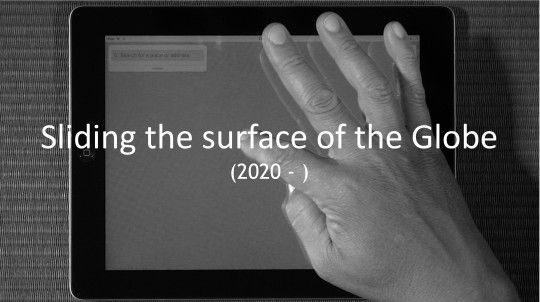
Sliding the surface of the Globe © 2023 Jun'ichiro ISHII
Exhibition : 2024.10.04 - 11.11 "9th Çanakkale Biennial - Let Time Run its Course" Çanakkale, Turkey 2023.05.14 - 10.07 "STRANGE THINGS" Alšova jihočeská galerie, Hluboká nad Vltavou, Czech Republic 2023.01.07 - 03.19 "瞑想のための球体 | Balls for Meditation" Gallery TOM, Tokyo, Japan 2022. "Wilgefortis" Online Group Exhibition
【>> 日本語でもっと読む】 【>> Read more in English】
#sliding_the_surface_of_the_globe#video_work#kyoto#tokyo#japan#paris#lyon#france#sydney#australia#hluboká_nad_vltavou#czech_republic#v12
0 notes
Text
DO NOT ART public sign project
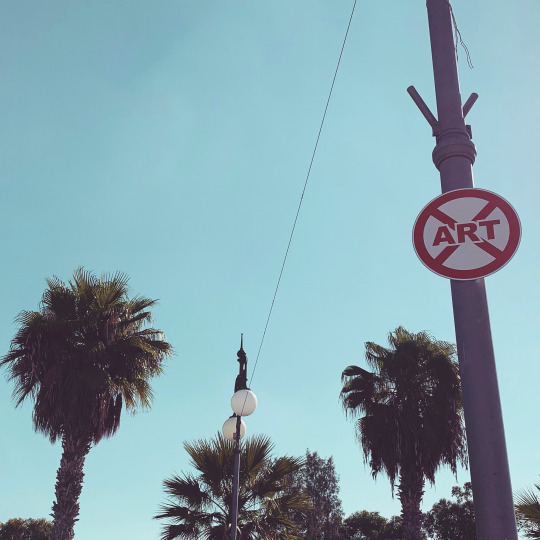
DO NOT ART at Larnaca, Cyprus © 2021 Jun'ichiro ISHII
I am prohibiting ART under the name of ART. Anyone who has done “ART” in the prohibited area will be asked to accompany the artist voluntarily and will be questioned in the curator’s office. If you are found by the curator to have done so, an ART violation report will be posted on the wall with your name and you will be given a strict warning.
アートの名のもとに、アートを禁止いたします。禁止区域で「アート」した人は任意同行をお願いし、学芸員室で取り調べをさせて戴きます。また学芸員により「アートした」と判断された場合には、実名入りの芸術違反調書を壁に貼り出し厳重注意致します。
Exhibition : 2024.04.12 - 05.12. “DO NOT ART | アート禁止” KIKA gallery, Kyoto, Japan 2021.10.13 - 11.26. “Limitless Limits - Larnaca Biennale 2021” Larnaca, Cyprus 2019.08.11 - 08.14. “TODAY IS YESTERDAY’S TOMORROW” HIGURE 17-15 cas, Tokyo, Japan 2019.07.05 - 07.18. “SPURT” Galerie Aube, Kyoto University of Art and Design, Kyoto, Japan
0 notes
Text
360° HORIZON or Différance
【English below】
「360°の水平線」あるいは「差延」

『「A は A である���と同一性を断言した瞬間から「非同一性」が生まれる』 (ゲオルク・ヴィルヘルム・フリードリヒ・ヘーゲル / 1770-1831)

『意志とは根源的な矛盾であり、「差異」とは必然的に、なににも還元することのできない力同士の拮抗である』 (フリードリヒ・ニーチェ / 1844-1900)

フェルディナン・ド・ソシュール(1857-1913)は、一般言語学に関する講義において、「言語には差異しかない」と述べました。
ソシュールによれば、記号の意味は、他の記号との違いによってしか規定されません。つまりひとつの記号は、他の諸記号が「不在」であることによってのみ「意味」を獲得するのです。

ジャック・デリダ (1930 - 2004) は、このソシュール的な「差異」のあり方を「痕跡」として捉え、そこに 時間的な���れ、「ズレ」を見出しました。
例えば、正確にひとつの概念を説明しようとすれば、そこに加わる供述、描写、説明は、もっと多くの他の概念を必要とするでしょう。

必然的に伝わる内容にはますます「差異」が発生し、「不在」であることで意味を獲得する概念は、その現前が、どんどん「遅延」してゆくことになります。
デリタはこの「差異(difference)」が「遅延 (deferral)」してゆく様を指して、「差延(différance)」という造語を生成しました。

「差異(difference)」が「遅延(deferral)」してゆく様、デリダが生成した「差延(différance)」とは、『語でも概念でもない』とされますが、作品「360° HORIZON」は、この思考を、わたし自身の身体で体現しようと試みるパフォーマンスです。

壁のある一点にランダムに点をとり、ここから水平器で、点の「位置」を水平方向にトレースしながら、展覧会場の壁 に鉛筆で一本線を引いてゆきます。
水平器で内壁を伝い、室内を一周してきた線は理論上、最初のポイントに戻って来ます。しかし、壁に鉛筆の痕跡を残しながら移動してきた「位置」が、いざ最初のポイントに戻ってくると、そこには「誤差」が生じます。
当然ですが、わたしは正しく線を引こうと試みます。そして正確であろうと努めているにも関わらず、生じてしまうこの「誤差」こそが、作品 «360° HORIZON or Différance»です。
◉

"'A = A' - non-identity is born from the moment we assert an identity" (Georg Wilhelm Friedrich Hegel, 1770-1831)

"Will is fundamentally paradoxical, difference inevitably is two powerful people locked in struggle unable to resolve anything." (Friedrich Nietzsche / 1844-1900)

Ferdinand de Saussure (1857-1913) in his seminars concerning general linguistics said: "in language there's nothing but disparity".
According to Saussure, the meaning of symbols can only be prescribed by their difference from other symbols. In other words, one symbol gets its meaning from the absence of other symbols.

Jacques Derrida (1930 - 2004) interpreted Saussure's 'differences' as 'traces' noticing a slight time lag.
For example, when trying to explain a certain concept accurately, the testimonials, descriptions and explanations call for a greater number of other concepts.

Naturally, 'differences' increasingly occur in the information being conveyed and the concept's meaning, composed of 'absences' is gradually delayed before our eyes.
Derrida coined a new word to describe how these di erences are delayed (deferred): "différance".
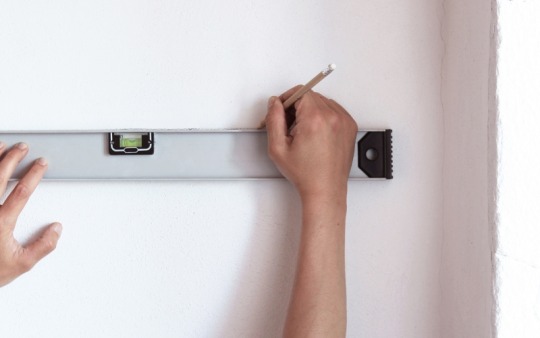
Although the delay de ned as neither a language nor a concept. the work "360° HORIZON" is a performance that tries to embody this thought with my own body.

I take a random point on the wall. Here I use a level to trace the point's position in a horizontal direction, drawing a line across the exhibition space wall with pencil.
Then I move to the next wall, and the back wall, and come all the way around to where I started. Logically I should return to the point where I started. However, as I moved around the room leaving a trail of pencil, when I returned to the starting point I would find that the measurement was off.
Naturally, I’m expecting perfect accuracy. However no matter how careful I am to draw a perfectly horizontal line, this kind of measurement error occurs. This slight gap between my intention and what actually I have done is the work «360° HORIZON or Différance».
◉

◉
16 series of photographs / 6 edition each
Produced at Holiday House Settlement, Lagada, Lesbos, Greece Special thanks : Andreas Sell (DE) / Catriona Gallagher (UK)
/ / / / / /
Performance : 2019.08.10. HIGURE 17-15 cas, Tokyo, Japan 2019.02.16. Vereinigung bildender Künstlerinnen Österreichs (VBKÖ), Vienna, Austria 2018.12.05. Galerie Aube, Kyoto University of Art and Design, Kyoto, Japan
0 notes
Text
Matryoshka Horizon or Bottle of Horizon

Matryoshka Horizon or Bottle of Horizon #01 © 2016 Jun'ichiro ISHII
Universality applies spontaneously inside a vessel.
However, the appearance will be different depending on form of the vessel.
/ / / / / /
Exhibition : 2018. “Kronstadt Stories-3. Slowness” Museum of history / Museum of printing, St.Petersburg, Russia
Work @ NCCA Art Residence, Kronstadt, St.Petersburg, Russia

Matryoshka Horizon or Bottle of Horizon #02 © 2016 Jun'ichiro ISHII
As a culturally specific artist, my works are always based on my hypothesis. Human perception is like a vessel that is formed by experiences, which are mostly had within one's own culture.
In this vessel, even universal values are translated into different contexts and shapes and therefore the truth shows varied aspects.
#Matryoshka Horizon#Bottle of Horizon#Cultural Sketch#Conceptual Work#Photo Work#St.Petersburg#Russia
0 notes
Text
relatively heavy metal
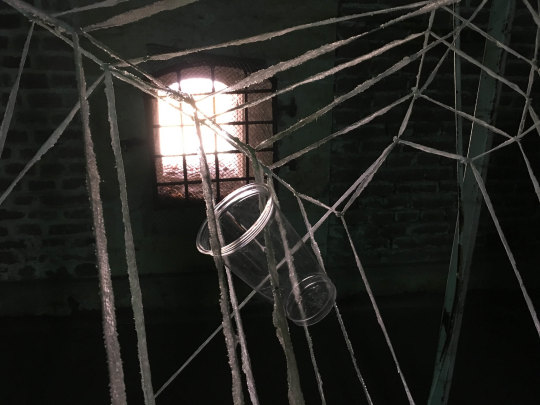
relatively heavy metal © 2017 Jun'ichiro ISHII
Work at Josefov fortress, Jaroměř, Czech Republic
Image exhibited : 2019.06.28 - 09.16. DOX — Center for Contemporary Art, Prague, Czech Republic 2017.08.24 - 09.24. Michal mine, Ostrava, Czech Republic
Curated by Pavel Forman (CZ) / Tomáš Koudela (CZ) Supported by "ART-BRUT-ALL"
0 notes
Text
Bottle in Landscape

Bottle in Landscape © 2016 Jun'ichiro ISHII
Work at Kunstlerhaus Dortmund, Dortmund, Germany
The Ruhr region of Germany, which was once famous as a huge industrial area. Many of these heavy industrial facilities have been demolished, but some are preserved as historical legacy. The “fragments” of such history that suddenly appear in the countryside seem landscape has been cut out and bottled.
かつて巨大な工業地帯として名を馳せたドイツのルール地方。工場施設の多くはすでに解体されましたが、その一部は現在でも歴史的建造物として保存されています。田園風景に突如として現れるそうした巨大工場の「断片」は、まるで連続している風景が切り取られて、瓶詰めされたかのようです。
0 notes
Text
Balloon
"土地には落花生ときびが栽培され、河では貝を収獲していた蘭芝島が、急激なソウルの巨大都市化とともに1978年、ゴミの埋立地となりました。以来1993年までの15年間、生活ゴミや建設廃木材、産業廃棄物など約92百万㎥のゴミが埋めら、約90メートルの頂きのない二つのゴミの山となってしまいました。" [ Reference : Story of Nanjido ]
この蘭芝島での三ヶ月間のレジデンスプログラム参加中、わたしは生活から出る、個人的なゴミを集めていました。本作はこれらのゴミと風船によって構成されています。
ヘリウムガスで膨らんだ風船は、ゴミを何処かへ運び去るようなイメージを持っています。しかし、いっときは作品の素材でもあったこれらの風船もまた、展覧会の後半には浮力を失い、まるでゴミのように会場内に散らばります。
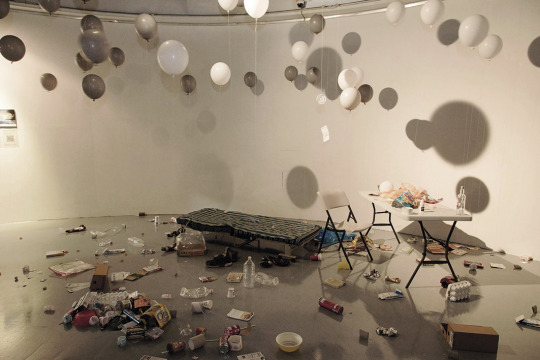
Balloon © 2013 Jun'ichiro ISHII
"Nanjido was converted into a landfill in the middle of the rapid urbanization of Seoul in 1978. From that time to 1993, 92 million tons of garbage including household wastes and construction and industrial wastes were dumped on the island, resulting in two massive mountains of garbage measuring over 90 meters in height." [ Reference : Story of Nanjido ]
During my three-month residency program on Nanji-Island, I have been collecting personal trash from my daily life. The installation is composed of those trash, and balloons.
The balloons, inflated with helium gas, seem to carry the trash away. However, they lost their buoyancy in the latter half of the exhibition, and the material that was once the material of an installation will scattere on the exhibition site like trash.
/ / / / / /
Exhibition : 2013.06.11 - 06.16 "ONEPLUSONEPLUSONEPLUSONE" SeMA Nanji Exhibition Hall, Nanjido, Mapo-gu, Seoul, South Korea
Supported by SeMA NANJI RESIDENCY
0 notes
Text
Sunny Table
��温43度、真夏のラマダン中のイラン、テヘラン市にて作品を制作する機会がありました。
日の出から日没まで飲食が出来ないこの期間、私にとっての一番の興味は食卓と太陽の関係でした。
本作は鏡と銀のテーブルセットの非常にシンプルな構成です。日中の太陽光を食事の準備が整った食卓へと招待しながら、今回私は本インスタレーションを、短いイラン滞在中の文化のスケッチとして紹介します。
【ラマダーン】 ラマダーン (アラビア語: رمضان )は、ヒジュラ暦の第9月。日本ではラマダンともいう。ペルシア語など非アラビア語圏における発音ではラマザーン、ないしラマザンともいう。この月の日の出から日没までのあいだ、イスラム教徒の義務の一つ「断食(サウム)」として、飲食を絶つことが行われる。「ラマダーン」を断食のことと誤って捉える人も少なくないが、あくまで月名である。 【出典: フリー百科事典ウィキペディア(Wikipedia)】

Sunny Table © 2011 Jun'ichiro ISHII
Tehran, Iran, 43 degrees Celsius, in the middle of summer, during Ramadan.
My interest during this period, when eating and drinking are prohibited from sunrise to sunset, was the relationship between the table and the sun.
This simple installation is composed by mirror and silver table sets. By inviting sunlight to the table, I have presented this image as a cultural sketch from my short stay in Tehran.
【Ramadan】 Ramadan (Arabic: رمضان Ramaḍān,Persian: Ramazan IPA: [rɑmɑˈdˤɑːn];variations Turkish: Ramazan) is the ninth month of the Islamic calendar, which lasts 29 or 30 days. It is the Islamic month of fasting, in which participating Muslims refrain from eating, drinking and sexual intimacy with their partners during daylight hours and is intended to teach Muslims about patience, spirituality, humility and submissiveness to God. [From Wikipedia, the free encyclopedia]
/ / / / / /
Exhibition : 2011.08.05 - 08.17 "Junction Box" Mohsen Gallery / Atbin Art Gallery, Tehran, Iran
Curated by Amirali Ghasemi (IR) Supported by Parking Projects (IR)
0 notes
Text
Arc de Verre

Arc de Verre © 2010 Jun'ichiro ISHII
0 notes
Text
Ondulation
今日、わたし達の発展した社会を見渡した際、わたし達は競い合いながら物事を大げさにすることに慣れ、日々ますますそのように加速してゆくようにも見えます。しかし今一度、自身の周囲を等身大の世界として眺めた場合、例えば静かな泉の表面を打つ水の一滴は、その様相をすっかり変えてしまう程の充分な力を持っているのかもしれません。
カジノの町マカオの豪華な噴水は、もっと目立つように、もっと壮大であるようにと、日々競い合っているように見えます。しかし、人々の生活が密集する住宅街で、路地裏の上空に干��れた洗濯物から、或はクーラーの室外機から飛んで来た一滴の水の雫がわたしの首筋にあたった時、それは盛大な作り物の水芸よりも、わたしの思考を変化させるのに十分な驚きを持っていました。
本作は愉快な楽しみの何事をも提供しません。覗き込んだ水面に移るわずかな像が、繰り返し繰り返し、退屈に壊されてゆくばかりです。
ユートピア像水鏡に似たり-- 明日がいつも今日より良いなら、その良さの意味は失われます。ひと雫の露から滝の咆哮を知る。水面に走る静かな波紋に、崩れる像に己を見つける。わたしはこれが最も肯定的な面の東洋思考だと考えています。

Ondulation © 2009 Jun'ichiro ISHII
Today, when we look out over our modern society, it seems we all got used to exaggerating things competitively and are accelerating the situation. However, if you turn back to your human-size reality, a water drop tapping a calm pond is sometimes enough to change its images.
The lavish fountains of Macau, the city of casinos, seem to be in daily competition to be more prominent and more spectacular. However, when a water drop from hanged up laundries or an outdoor unit of air conditioners at a back alley in a residential area unexpectedly tapped my neck, I realized that such a small droplet was much more powerful to change my vision.
This work doesn't offer any pleasant enjoyment. Only reflected image on the surface repeatedly and tediously flickers.
The utopian vision is your own reflection. If tomorrow were always better than today, the meaning of "the better" would be lost. Imagine the roar of a waterfall from a droplet, and find oneself from a collapsing image in calm undulation, I trust that this is the most positive aspect of Oriental thought.
----------
Exhibition : 2009.06.13 - 08.09 "Utopia - Interpretation of New Era" OX warehouse, Macau SAR, China
Curated by : Gigi Lee Yee Kee (MO) Supported by : OX warehouse / St.Paul Fine Art
0 notes
Text
28 of June
【>> 日本語で読む】
On June 28, 2005, I had the opportunity to show my work at the studio where I was staying. However, as I had just arrived at the studio, I did not yet have any work that I could show to the public.
I wondered if I could make an ordinary day into something special - I imagined if I could make "June 28" itself into an artwork.
I decided to draw a large "28. June" by pins and thread, while spending the whole day of June 28.
◉
From the moment the date changed to June 28, I set to work. I worked alone all night, and asked the audience who started to come to the studio from the morning to participate, I continued this process for 24 hours until the day of June 28 ended.
The work "28.June" drew nearer completion over time, but as time passed, the day of "June 28" began to end. And finally at the moment when June 28 finally ended, the traces of the labor of "June 28" were left on the wall, which means the work "28. June" was born.

28 of June © 2004 Jun'ichiro ISHII
◉
The integer "6" is the smallest "perfect number" among natural numbers. The only numbers that can be divided into the number 6 excluding 6 itself, are 1, 2, and 3. And if you add 1, 2, and 3 together, the sum becomes 6 again.
A number like this, where the sum of its divisors is the same as the original number, is called a "perfect number."
It is said that "perfect numbers" are one of the numbers named by Pythagoras, who believed that "everything is number." The next smallest perfect number after "6" is "28", which is 1+2+4+7+14.
It is said that medieval Bible scholars believed that 6 represented the six days in which God created the world (Creation) and 28 represented the orbital period of the moon, and that these two numbers symbolized God's perfection on earth and in heaven.
It is said that ancient Greek mathematicians knew two other perfect numbers besides "6" and "28", "496" and "8128", but it is not known how many perfect numbers exist among natural numbers. Only 10 perfect numbers had been discovered by the end of the 19th century, and as of 2004, only 41 have been discovered. (As of 2019, there are 51.)
>> The List of Perfect Numbers
Therefore, "June 28" is a very romantic number day, made up of two perfect numbers, n, that satisfy the divisor function σ(n) = 2n, arranged in ascending order.
Well, actually, I don't know well what that formula means, but if you look at an ordinary day carefully from various angles, it may turn out to be a special day in some way.
/ / / / / /
Performance : 28 of June 2005, Ssamzie Space, Seoul, South Korea
0 notes
Text
Choy E-W
ウズベキスタンは古代シルクロードにおける交易の要所として栄えました。
2008年、わたしはタシケントとブハラにて、中央アジアの「もてなしの文化」を、特にお茶の習慣から発見する機会に恵まれました。 日本では「お茶(Ocha)」といえば自然と緑茶(Green tea)を指しますが、西洋ではそれが紅茶(Black tea)になります。ウズベキスタンでお茶を注文しようとすると、必ず「K'ok Choy(緑茶)」か「Qora Choy(紅茶)」を選ぶことになります。 古いオアシスの都の寛大なもてなしか、或いは異文化同士を結ぶ平和的な握手か、わたしにとってそれは非常に新鮮で、また非常に印象深い文化の素顔でした。 わたしは緑茶葉と紅茶葉の2種類を使って、東西を示す一本の線を描きました。東には緑茶葉、西には紅茶葉、中央ではそれらが交じり合う。これは、短い滞在の中で得た文化観察のレポートであり、中央アジアにおけるわたしの第一印象を率直に綴った、シンプルなインスタレーションによる“文化のラフスケッチ”です。

Choy E-W © 2008 Jun'ichiro ISHII
Uzbekistan flourished as a key trading hub along the ancient Silk Road.
In 2008, I had the opportunity to discover the spirit of Central Asian hospitality in Tashkent and Bukhara—especially through the culture of tea.
In Japan, when we say “tea” (Ocha), it naturally refers to green tea. In the West, however, it generally means black tea. In Uzbekistan, when you order tea, you are always asked to choose between K’ok Choy (green tea) and Qora Choy (black tea).
To me, this custom was a vivid and memorable reflection of culture—whether it was the generous hospitality of the old oasis cities or a peaceful handshake between different cultures.
Using both green tea leaves and black tea leaves, I drew a line symbolizing East and West: green tea on the East side, black tea on the West, and the two blending in the center.
This work is a simple installation—a rough sketch of culture—serving as a brief report of my observations during a short stay, and an honest expression of my first impression of Central Asian culture.
———
Exhibition : 2008.10.21 - 10.27 "4th TashkentAle" Caravanserai of Culture, Tashkent, Uzbekistan
Organized by : The Forum of Culture & Arts of Uzbekistan Foundation The Academy of Arts of Uzbekistan The Tashkent House of Photography International Caravanserai of Culture
Supported by : POLA ART FOUNDATION (JP) THE JAPAN FOUNDATION
Special Thanks : Farrukh USMANOV (UZ) / Pavel KIM (UZ)
1 note
·
View note
Text
Come Tehran from We
Exhibit Description of the Never Been to Tehran
Andrea Grover and Jon Rubin, Co-organizers
Imagine a city that you've only seen in reproductions or perhaps have merely heard about. A place, like many others, that only exists for you through indirect sources--the nightly news, hearsay, literature, magazines, movies, and the Internet. Using these secondhand clues as firsthand research materials, invited worldwide participants--who have Never Been to Tehran--will take photographs (from their home base) of what they imagine Tehran to look like.
Contributors will upload their photos daily to an on-line photosharing site, which will be projected as a slideshow simultaneously in galleries and public spaces around the world (including Tehran). Anything that anyone might take a photograph of is fair game, just as long as it feels like Tehran. For the international contributors to this exhibition, the task is to search through their daily lives for clues to a foreign place, for the possibility that somewhere else exists right under their noses and that, like some clunky form of astral projection, one can travel to other lands without leaving home.
New information technologies are expanding the possibility of knowing a place to which you've never traveled. Hosts of amateur and commercial websites and podcasts about a given city, its economy, demographics, culture and subculture have opened the way for a new vernacular of representation. As Tehran's image is regularly depicted in the dominant media, it is a compelling challenge for the participants in this exhibition to sift through the glut of images and information to cull out a personally constructed version of an unfamiliar place.
For viewers in Tehran, the exhibition presents a chance to witness an unusual mirroring of their globally projected image, taken from the daily lives and environs of outsiders. Collectively, the artists and viewers of Never Been to Tehran will be charting a liminal space stuck somewhere between here and there that in our contemporary existence just might be home.
>> Online Exhibition : Never Been to Tehran

Come Tehran from We © 2007 Jun'ichiro ISHII
Exhibit Description of the Never Been to Tehran
企画:アンドレア・グローヴァー & ジョン・ルービン
あなたが写真や映像でしか見たことがなかったり、あるいはただ話に聞いたことしかない都市を想像してみてください。夜のニュース、うわさ話、文学、雑誌、映画、インターネットといった間接的な情報源を通してしか存在しない場所。『Never Been to Tehran』では、実際にテヘランを訪れたことのない世界中の参加者が、そうした二次的な手がかりを一次的なリサーチ素材として活用し、自らの想像する「テヘランらしい風景」を自国から撮影します。
参加者は写真をオンラインの写真共有サイトに毎日アップロードし、それらは世界各地のギャラリーや公共空間(テヘランを含む)で、スライドショーとして同時に投影されます。誰でも撮影する可能性があるものはすべて対象となりえます──それが「テヘランのように感じられる」ものであれば。
この展覧会に参加する国際的なアーティストたちは、日々の暮らしの中から「異国の手がかり」を探し出します。つまり、どこか遠く離れた場所が、実は自分の足元にも存在しているかもしれないという可能性。まるで不器用な幽体離脱のように、家から一歩も出ずに他の土地へと“旅”することです。
新しい情報技術の発展によって、実際に行ったことのない場所を知る可能性は広がっています。ある都市についてのアマチュア・商業的なウェブサイトやポッドキャストは、その経済、人口統計、文化、サブカルチャーに関する新しい“日常語”の表現手段を切り開いています。テヘランという都市は、主流メディアの中で繰り返しイメージとして提示されているため、参加者たちにとっては、その膨大な情報の中から自分なりに構築した“未知の場所”のイメージをつかみ取るという、刺激的な挑戦となるのです。
そしてテヘランの観客にとっては、自分たちが世界にどう投影されているか、その外側から見た日常の断片として、思いがけない“鏡像”を目撃する機会となるでしょう。
『Never Been to Tehran』の参加アーティストと鑑賞者たちは、「ここ」と「あそこ」のあいだに浮かぶような、境界的な空間を描き出します──そしてそれは、現代の私たちにとっての「ホーム」なのかもしれません。
>> Online Exhibition : Never Been to Tehran

Come Tehran from We © 2007 Jun'ichiro ISHII
Work Concept "Come Tehran from We"
Jun'ichiro ISHII
I focus my artistic practice on site-specific art—art that is, quite literally, “specific to a site.” That is to say, I place great importance on conducting research in the location where I create, and I develop works that take into account the land, climate, geographical conditions, and historical context of the site—or simply works that are inspired by being in that place. In this sense, the exhibition Never Been to Tehran presents a somewhat unfamiliar challenge for me.
For this project, I chose to expand upon the concept of Never Been to Tehran and developed a highly personal approach. The photo series titled We Come from Tehran focuses on two individuals from Tehran who live in my local community. It represents a very personal, subjective impression of Tehran—my own imagined version of the city.

Come Tehran from We © 2007 Jun'ichiro ISHII
When I experience cultural or habitual differences abroad, I’m sometimes asked, “How is it in your country?” Even when I’m asked, “What about Japanese people?”—though I am Japanese—I often struggle to answer, because I cannot speak on behalf of all Japanese people. My usual response is, “It depends on the individual.” Still, my personal opinion may end up shaping someone's impression of Japanese people as a whole.
In other words, impressions are ultimately shaped by individual perspectives. It may be that people living overseas unintentionally construct highly personal images of distant places—based not on direct knowledge, but on singular encounters or relationships.

Come Tehran from We © 2007 Jun'ichiro ISHII
わたしは「サイト・スペシフィック」アートを中心に創作活動をしています。「サイト・スペシフィック」とは文字通り、「場所特別な」アートです。つまりわたしは、作品制作の為の現地リサーチを重要視し、土地、風土、その地理的条件や歴史的文脈を考慮した作品、あるいは単にその場所で得たインスピレーションを基盤とした作品を発表しています。そのような意味で今回の展示会、「Never Been to Teheran」とはわたしにとって、少々未知なる挑戦となります。
わたしは、この「Never Been to Teheran」のコンセプトを拡張し、非常に個人的なコンセプトを立てました。「 We come from Teheran」と題した写真シリーズは、わたしの生活圏内に生活する、テヘラン出身の二人に焦点を当てています。これは非常に個人的な、「私的」なテヘランの印象です。

Come Tehran from We © 2007 Jun'ichiro ISHII
海外で文化・習慣的な違いを感じたような場合に、「あなたの国の場合はどう?」というような質問を投げかけられることがあります。日本人の場合はどう?と聞かれても、わたしは日本人ですが、日本人の全体ではなく、返事に困ってしまいます。「人は人によって違う」、というのがわたしの返答であったりするのですが、案外その人たち(質問者)にとっては、わたしの意見が日本人の印象を決定する一要素にもなってしまうのかもしれません。つまり、裏を返せば印象というものはあくまで個々の認識であり、例えば海外に生活する個々が、ある地球の離れた場所の印象を、誰かの非常に個人的なレベルにおいて形成していたりするのかもしれません。
Exhibition : 2007.10.16 - 11.19 Parkingallery, Tehran, Iran Caravansarai, Istanbul, Turkey San Francisco Arts Commission Gallery, USA Media and Interdisciplinary Arts Center, New Zealand Koh-I-Noor, Copenhagen, Denmark Mess Hall, Chicago, USA Pittsburgh Cultural Trust, Pittsburgh, USA Embryosalon, Berlin, Germany
Orgnized by : Andrea Grover and Jon Rubin (USA)
Special Thanks : Amirali Ghasemi (IR) Reza HATAMI (IR) / Parinaz HATAMI (IR)
0 notes